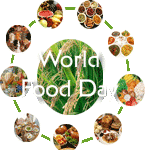The Food and Agriculture Organization (FAO) of the United Nations rejoices World Food Day every year on October 16, the date of FAO's origin in 1945.
What do people do?
Several events are structured on and around World Food Day. On and around October 16, a wide-ranging agenda is organized at the FAO's head office in Rome, Italy. The curriculum is aimed at leaders of political and non-political organizations at all levels and at increasing press awareness on topical issues around food supply. Further UN organizations and universities around the world systematize symposia, conferences, workshops and presentations of meticulous issues around food production, distribution and security. In accumulation, special initiatives, such as the "International Year of Rice" in 2004 and the "International Year of the Potato" in 2008 were commenced.Across the globe, many special events are controlled to raise awareness of problems in food supply and distribution and to raise money to support projects to aid in the cultivation of food plants and the distribution of food. An example of this is TeleFood, which funds micro projects to help small-scale farmers at the grassroots level. The projects intend to help farmers be more prolific and improve both confined communities' access to food and farmers' cash income. Fundraising events consist of sponsored sports events, charity auctions, concerts, and marches.
World Food Day is a global ceremony and not a public holiday.
Background
 The FAO aims to hoist levels of nutrition across the globe, progress agricultural productivity at all levels, enhance the lives of rural populations and donate to the growth of the world economy. It also provides aid to countries changing their agricultural policy, to support regions out of dearth situations, to help employ apt technology and facilitate a neutral environment to argue issues around food production.
The FAO aims to hoist levels of nutrition across the globe, progress agricultural productivity at all levels, enhance the lives of rural populations and donate to the growth of the world economy. It also provides aid to countries changing their agricultural policy, to support regions out of dearth situations, to help employ apt technology and facilitate a neutral environment to argue issues around food production.At the FAO's 20th session in Rome, Italy, in November 1979 the forum called for the observance of World Food Day on October 16, 1981, and on the same date each year. The UN General Assembly authorized this decision on December 5, 1980, and urged governments and international, national and local organizations to give to observing World Food Day. World Food Day has been held every year ever since 1981.
Symbols
The FAO's sign consists of a circle. Inside the circle is a graphical icon of an ear of wheat and the letters F, A and O. The FAO's motto "fiat panis" (let there be bread) appears under the ear of wheat. The first version of this design was a badge distributed to delegates at an FAO conference in Copenhagen in 1946. The modern version was registered with the United International Bureaux for the Protection of Intellectual Property on July 1, 1964, and has been used extensively from the time when about 1977.A World Food Day official symbol consists of three intangible human figures harvesting, distributing and sharing food. The figures are illustrated in a bluish-grey color and the food in an orange shade. This draws concentration to the food. The whole picture aims to bring notice to the necessity and joy of growing, harvesting and distributing food.
This World Food Day, we are facing incredible challenges in the fight in opposition to hunger.
Food price hikes over this past year have pushed some 70 million people into excessive poverty, according to the World Bank. And, when citizens living in conditions of paucity are spending up to 80 percent of their income on food, such price hikes result in them spending less on food and other basic needs.
Moreover, 13 million people in East Africa are affected by the worst famine the world has seen in 60 years. In Somalia, the drought has led to devastating famine.
There are now almost one billion hungry people in the world - and more than 90 percent of them are unremittingly hungry, which means they are not getting enough food every day to be healthy and lead active lives.
The Hunger Project (THP) spotlights on building confined resilience and skills so communities can end their own hunger. As a result, they are superior able to cope when emergencies like drought, famine, or sudden increases in food prices do arise.
For instance, small farmers' contact training and credit from our epicenters in Africa, and in addition to improving their own livelihoods, they also add to a community food bank that is stocked for times of drought. Or, as you can see from this story from Bangladesh, trained THP animators and leaders right through our Program Countries encompass a built-in network that is equipped to implement local emergency aid efforts in partnership with government or humanitarian NGOs.
We are all tied to a global food scheme. In a world facing the disputes of a growing residents, skewed resource distribution and an erratic climate, one of the best ways to combat worldwide food insecurity is to provide in small producers especially women farmers and eliminate the barriers that frontier their productivity and ability to souk their produce.
Creating this awareness is what a World Food Day dinner is all about. Use the possessions below to host a fun, educational and appealing conversation about food justice.
Food prices have continued to rise of late, and this has led to millions of people being unable to meet their daily food needs. The price tramps unfortunately also have meant that there is less money for food aid at a time when it is most essential.
World Food Day events are raising money to maintain initiatives that will ease population growth, boost incomes and prepare farmers to protect their harvests against the negative effects of climate change, among others.
According to the World watch Insitute, the number of undernourished people worldwide has decreased since 2009 to nearly one billion, a number that is still unacceptably high. The FAO reports that one-third of the African population is underfed and one child in Africa dies every six seconds because of malnutrition.
Robert Engelmann, president of the World watch Institute, said:
There's something wrong with a world in which a billion people can't get enough to eat for normal health while a different billion people threaten their health by overeating.
Since 1981, World Food Day has been observed on October 16 in recognition of the founding of the FAO. On October 16, 2011, World Food Day events are raising money to support initiatives that will ease population growth, boost incomes and prepare farmers to protect their harvests against the negative effects of climate change, among others.


